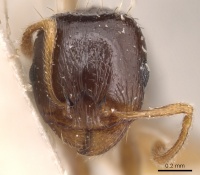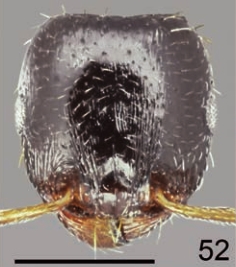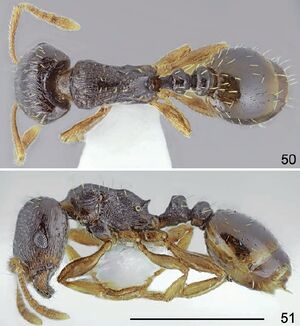Tetramorium hippocratis
| Tetramorium hippocratis | |
|---|---|

| |
| Scientific classification | |
| Kingdom: | Animalia |
| Phylum: | Arthropoda |
| Class: | Insecta |
| Order: | Hymenoptera |
| Family: | Formicidae |
| Subfamily: | Myrmicinae |
| Tribe: | Crematogastrini |
| Genus: | Tetramorium |
| Species group: | semilaeve |
| Species: | T. hippocratis |
| Binomial name | |
| Tetramorium hippocratis Agosti & Collingwood, 1987 | |
Specimens were collected in dry habitats from 10 to 350 m. Nests were found at: a sandy dirty road at the seaside, roadsides within pine and oak forest, and on riverbanks of seasonal rivers. In the only nest with sexual forms 6 gynes were collected. (Salata and Borowiec 2017)
Identification
Salata and Borowiec (2017) - Tetramorium hippocratis is the only species of the Tetramorium semilaeve complex with dark colored workers (dark brown to black). The darkest forms of Tetramorium atlante, Tetramorium kephalosi, and Tetramorium bellerophoni are never as darkly brown as the palest forms of T. hippocratis. In comparison with dark specimens of T. kephalosi the propodeal spines of T. hippocratis are larger and placed closer to the top of mesosoma than in T. kephalosi.
Gynes of T. hippocratis differ from all species of Tetramorium semilaeve complex in their dark brown to black body. Together with T. atlante they have the most sculptured scutum, with longitudinal striation often extending from the base to half the length of scutum.
Males of T. hippocratis differ from all species of T. semilaeve group in their dark brown to black body. In structure of male genitalia the most similar species is T. kephalosi. Both species have sharp lamella on inner margin of apex of paramera but in T. hippocratis genitalia in lateral view are more distinctly constricted before apex than in T. kephalosi with more angulate inner angle. Males of T. hippocratis are smaller from males of T. kephalosi with ML 1.698-1.827 vs. 1.831-2.022 and have more converging posterad frontal lobes (FL/FR 1.152-1.267 vs. 1.0-1.146).
Keys including this Species
- Key to Tetramorium semilaeve complex males
- Key to Tetramorium semilaeve complex queens
- Key to Tetramorium semilaeve complex workers
Distribution
This is a rare species, recorded from the Aegean Islands, Crete, the Dodecanese, Peloponnese and Thrace (Borowiec et al., 2022).
Latitudinal Distribution Pattern
Latitudinal Range: 41.9° to 36.71857°.
| North Temperate |
North Subtropical |
Tropical | South Subtropical |
South Temperate |
- Source: AntMaps
Distribution based on Regional Taxon Lists
Palaearctic Region: Greece, Türkiye (type locality).
Distribution based on AntMaps
Distribution based on AntWeb specimens
Check data from AntWeb
Countries Occupied
| Number of countries occupied by this species based on AntWiki Regional Taxon Lists. In general, fewer countries occupied indicates a narrower range, while more countries indicates a more widespread species. |

|
Estimated Abundance
| Relative abundance based on number of AntMaps records per species (this species within the purple bar). Fewer records (to the left) indicates a less abundant/encountered species while more records (to the right) indicates more abundant/encountered species. |

|
Biology
Castes
Worker
   
| |
| . | |
Queen
 
| |
| . | |
Male
  
| |
| . | |
Nomenclature
The following information is derived from Barry Bolton's Online Catalogue of the Ants of the World.
- hippocratis. Tetramorium hippocratis Agosti & Collingwood, 1987a: 56 (w.) TURKEY. [First available use of Tetramorium caespitum subsp. semilaeve var. hippocratis Emery, 1921b: 217; unavailable name.]
Unless otherwise noted the text for the remainder of this section is reported from the publication that includes the original description.
Description
Worker
Salata and Borowiec (2017) - (n=30): CL: 0.774 ± 0.04 (0.687-0.866); POC: 0.312 ± 0.02 (0.268-.357); CW: 0.762 ± 0.04 (0.659-0.841); FR: 0.267 ± 0.02 (0.223-0.288); FL: 0.271 ± 0.02 (0.229-0.296); SL: 0.563 ± 0.03 (0.486-0.648); OMD: 0.194 ± 0.02 (0.168-0.226); EL: 0.155 ± 0.02 (0.112-0.187); EH: 0.111 ± 0.01 (0.089-0.134); ML: 0.847 ± 0.05 (0.749-0.96); SPSP: 0.153 ± 0.01 (0.134-0.192); SPL: 0.112 ± 0.01 (0.089-0.142); PEL: 0.207 ± 0.01 (0.167-0.246); NOL: 0.161 ± 0.01 (0.142-0.179); PPL: 0.16 ± 0.02 (0.134-0.196); PEH: 0.266 ± 0.02 (0.232-0.302); NOH: 0.153 ± 0.01 (0.123-0.179); PPH: 0.249 ± 0.02 (0.209-0.291); MW: 0.48 ± 0.04 (0.402-0.57); PEW: 0.24 ± 0.02 (0.184-0.271); PPW: 0.274 ± 0.02 (0.223-0.318); CS: 0.768 ± 0.04 (0.673-0.853); EYE: 0.173 ± 0.01 (0.142-0.195); CL/CW: 1.017 ± 0.02 (0.964-1.049); FR/CS: 0.352 ± 0.01 (0.33-0.375); FL/FR: 1.01 ± 0.01 (1-1.06); SL/CS: 0.733 ± 0.02 (0.706-0.769); MW/CS: 0.625 ± 0.02 (0.592-0.668); PEW/PPW: 0.876 ± 0.04 (0.786-0.939); NOH/NOL: 0.953 ± 0.07 (0.800-1.085); NOH/PEL: 0.744 ± 0.07 (0.611-0.889); NOL/PEL: 0.781 ± 0.05 (0.714-0.889); PEH/NOL: 1.654 ± 0.06 (1.533-1.769); PEW/PEH: 0.892 ± 0.05 (0.75-0.98); CS/PEW: 3.214 ± 0.17 (2.979-3.787); CS/PPW: 2.812 ± 0.1 (2.563-3.012); CW/MW: 1.602 ± 0.05 (1.498-1.689).
Small to medium size, CS 0.768 [0.673-0.820]. In most specimens whole body dark brown, the darkest specimens almost black, appendages yellow. Head approximately as long as wide CL/CW 1.017 [0.964-1.049], with almost parallel sides, slightly concave occipital margin and rounded occipital corners. Eyes small, EYE 0.173 [0.142-0.195]. Frons moderately wide, FR/CS 0.352 [0.330-0.375], frontal lobes as wide as frons, FL/FR 1.01 [1.00-1.06]. Scape short, SL/CS 0.733 [0.706-0.769], without dorsal carina basally, surface smooth and shiny. Promesonotal dorsum slightly convex, metanotal groove very shallow, sometimes indistinct. Propodeal teeth short, triangular, apex of spine located approximately at 2/3 height of mesosoma. Dorsal surface of petiole flat to slightly convex, NOH/ NOL 0.953 [0.800-1.085], petiole moderately high, PEH/NOL 1.654 [1.533-1.769], postpetiole distinctly transverse. General appearance finely rugose, ground surface shiny. Head dorsum in workers from mature nests mostly longitudinally rugose, on sides shiny, in frontal part with diffused microreticulation between rugae but never appears dull, rugae extend occipital margin of head, occiput laterally from mostly smooth and shiny to partly with diffused rugar, sides in anterior half longitudinally rugose and shiny between rugae. In most specimens sides of frons with narrow area with diffused rugae but smooth area never exceeds 1/6 of the anterior surface of head; in extremely sculptured specimens almost whole frontal surface of head with long rugae with very narrow areas with diffused rugae laterally, in extremely fine sculptured specimens only frons with rugae, ocular area, top of head and postocular area smooth and shiny, the level of development of sculpture is partly correlated with size, small specimens usually have less developed sculpture than large and coloured specimens. Specimens from initial nests always have mostly reduced head sculpture (type series represents such specimens), with the development of the nest overwhelm strongly sculptured specimens. Alitrunk dorsum longitudinally rugose and microreticulate but never reticulate, also specimens with reduced head sculpture usually have complete rugae along pronotum, sometimes central part of promesonotal disc with small shiny area without sculpture. Sides of pronotum and meso- and metapleuron usually coarsely microreticulate, sometimes reticulation tends to form transverse lines but surface never appears striate or rugose, base of propodeal spines often with short radial rugae. Dorsum of petiolar node smooth and shiny with sides more or less carinate, lateral surface microreticulate. Dorsum of postpetiole smooth and shiny, sides microreticulate. First gastral tergite smooth and shiny. Whole dorsum, including head, covered with sparse setae, the longest on pronotum and the shortest on frons. Ventral surface of head with sparse short and 2-3 moderately long setae not forming a psammophore.
Queen
Salata and Borowiec (2017) - (n=6): CL: 1.046 ± 0.016 (1.036-1.079); POC: 0.372 ± 0.03 (0.324-0.403); CW: 1.12 ± 0.014 (1.101-1.14); FL: 0.393 ± 0.008 (0.381-0.403); FR: 0.392 ± 0.008 (0.381-0.403); SL: 0.758 ± 0.009 (0.748-0.773); OMD: 0.222 ± 0.012 (0.201-0.237); EL: 0.296 ± 0.01 (0.288-0.316); EH: 0.246 ± 0.011 (0.23-0.266); ML: 1.886 ± 0.05 (1.784-1.935); SPSP: 0.306 ± 0.013 (0.288-0.331); SPL: 0.203 ± 0.014 (0.18-0.216); PEL: 0.337 ± 0.009 (0.324-0.345); NOL: 0.221 ± 0.01 (0.201-0.23); PPL: 0.297 ± 0.017 (0.273-0.316); PEH: 0.454 ± 0.01 (0.446-0.475); NOH: 0.221 ± 0.016 (0.201-0.244); PPH: 0.463 ± 0.017 (0.432-302 S. Salata and L. Borowiec 0.489); MW: 1.189 ± 0.016 (1.173-1.216); PEW: 0.405 ± 0.01 (0.388-0.418); PPW: 0.511 ± 0.007 (0.503-0.521); CS: 1.082 ± 0.012 (1.068-1.108); EYE: 0.25 ± 0.007 (0.24-0.26); CL/CW: 0.933 ± 0.01 (0.909-0.949); FR/CS: 0.363 ± 0.004 (0.355-0.370); FL/FR: 1.003 ± 0.004 (1.000-1.009); SL/CS: 0.670 ± 0.01 (0.675-0.724); MW/CS: 1.098 ± 0.01 (1.084-1.120); PEW/PPW: 0.793 ± 0.02 (0.771-0.829); NOH/NOL: 1.003 ± 0.09 (0.875-1.142); NOH/PEL: 0.656 ± 0.06 (0.583-0.739); NOL/PEL: 0.655 ± 0.032 (0.622-0.696); PEH/NOL: 2.063 ± 0.09 (1.937-2.214); PEW/PEH: 0.892 ± 0.03 (0.848-0.935); CS/PEW: 2.674 ± 0.08 (2.573-2.8); CS/PPW: 2.118 ± 0.04 (2.058-2.161); CW/MW: 0.911 ± 0.009 (0.893-0.922); WAIST: 0.847 ± 0.02 (0.819-0.874).
Moderate size, CS 1.082 [1.068-1.108]. Head, thorax, petiole and postpetiole black, gaster dark brown, appendages yellowish. Head wider than long, CL/CW 0.933 [0.909-0.949], with straight subparallel sides, shallowly emarginate occipital margin and rounded occipital corners. Frons moderately wide, FR/CS 0.363 [0.355-0.370], frontal lobes as wide as frons, FL/FR 1.003 [1.000-1.009]. Scape short, SL/CS 0.670 [0.675-0.724], without dorsal carina basally, smooth and shiny. Head approximately as wide as scutum, MW/CS 1.098 [1.084-1.120]. Propodeal teeth short, triangular. Dorsal crest of petiolar node in frontal view truncate. Petiolar node dorsum steeply rounded backward. Petiole and postpetiole relatively narrow, but postpetiole distinctly transverse, approximately 1.4 times as wide as long, WAIST 0.847 [0.819-0.874]. General appearance shiny. Head dorsum, occiput and sides rugulose, ground surface indistinctly microreticulate but shiny. Frons longitudinally rugulose. Mesosoma flat, sides of pronotum visible from above. Scutum punctate along sides, mostly longitudinally striate extending to 1/4-1/3 length of scutum except smooth and shiny sides, anterior slope and median narrow stripe. Scutellum with striate anterior margin and corners and smooth and shiny central part. Sides of pronotum with distinct longitudinal striation, anepisternum in basal half smooth and shiny in dorsal half with fine longitudinal rugae, katepisternum in anterior 2/3 smooth and posterior margin third microreticulate and longitudinally to obliquely striate. Whole surface of petiolar node distinctly reticulate. Postpetiole with rounded sides, dorsum of postpetiole micro reticulate, sides granulate and striate. First gastral tergite smooth and shiny. Whole dorsum, including head, covered with short, sparse setae. Ventral surface of head with few short setae, and 5-7 longer setae 1.5-2.0 times longer than frontal setae, arising posteriorly to buccal cavity.
Male
Salata and Borowiec (2017) - (n=3): CL: 0.699 ± 0.016 (0.683-0.716); POC: 0.242 ± 0.014 (0.23-.259); CW: 0.817 ± 0.01 (0.806-0.823); FR: 0.235 ± 0.02 (0.215-0.258); FL: 0.286 ± 0.012 (0.273-0.298); SL: 0.335 ± 0.02 (0.316-0.36); OMD: 0.09 ± 0.02 (0.07-0.1); EL: 0.312 ± 0.007 (0.302-0.317); EH: 0.269 ± 0.01 (0.259-0.281); ML: 1.76 ± 0.06 (1.698-1.827); SPSP: 0.264 ± 0.02 (0.245-0.273); SPL: 0.24 ± 0.02 (0.215-0.259); PEL: 0.374 ± 0.014 (0.36-0.388); NOL: 0.221 ± 0.03 (0.187-0.245); PPL: 0.317 ± 0.014 (0.302-0.331); PEH: 0.321 ± 0.008 (0.316-0.331); NOH: 0.153 ± 0.02 (0.144-0.173); PPH: 0.432 ± 0.01 (0.417-0.446); MW: 1.215 ± 0.02 (1.194-1.227); PEW: 0.358 ± 0.005 (0.352-0.363); PPW: 0.475 ± 0.008 (0.474-0.476); CS: 0.758 ± 0.01 (0.745-0.768); EYE: 0.382 ± 0.01 (0.37-0.392); CL/CW: 0.856 ± 0.01 (0.847-0.872); FR/CS: 0.378 ± 0.01 (0.367-0.392); FL/FR: 1.223 ± 0.06 (1.152-1.267); SL/CS: 0.443 ± 0.03 (0.412-0.473); MW/CS: 1.603 ± 0.005 (1.597-1.607); PEW/PPW: 0.754 ± 0.01 (0.742-0.765); NOH/NOL: 0.7 ± 0.07 (0.625-0.769); NOH/PEL: 0.411 ± 0.05 (0.37-0.461); NOL/PEL: 0.589 ± 0.07 (0.52-0.654); PEH/NOL: 1.479 ± 0.25 (1.294-1.769); PEW/PEH: 1.116 ± 0.04 (1.065-1.148); CS/PEW: 2.114 ± 0.06 (2.05-2.158); CS/PPW: 1.594 ± 0.02 (1.568-1.613); CW/MW: 0.623 ± 0.002 (0.622-0.626).
Head, thorax, and petiole black, postpetiole and gaster brown, appendages yellowish. Head with convex sides, slightly rounded occipital margin and widely rounded occipital corners. Scutum distinctly wider than head. Propodeum with only indistinct angulation in position of propodeal teeth. Dorsal crest of petiolar node with obtuse transversal edge, slightly convex in frontal view. Head distinctly sculptured, with radial rugosities around ocelli, circular rugosities around antennal scapi and oblique rugosities on frons, dull. Area between eye and ocelli with distinct rugosities. Clypeus on whole surface with parallel rugosities. Frons with longitudinal striation. Scutum in anterior part and laterally smooth and shiny, behind Mayrian furrows mostly longitudinally striate stripe, only sides smooth and shiny. Scutellum from partly smooth and shiny to completely striate. Sides of pronotum microreticulate and finely striate. Anepisternum mostly smooth and shiny, only in posterior third striate, katepisternum almost completely smooth and shiny only along upper margin and in posterior corner microreticulate, propodeum microreticulate with longitudinal rugosities, dull. Dorsum of petiolar node microgranulate and microreticulate, dull, or only upper margin narrowly smooth and shiny, postpetiole mostly microreticulate and striate only top partly smooth and shiny. First gastral tergite smooth and shiny. Male genitalia stout, in lateral view only slightly constricted before apex with angulate inner angle, top moderately long and dense pubescent, dorsal margins of parameres straight, ventral margins deeply incised before apical hook, top of inner margin of paramere before apical denticle S-shaped, without dentiform plate extending beyond the sharp edge of paramere, only with sharp lamella.
Type Material
Salata and Borowiec (2017) - Syntype worker. Anatolia, Budrum, XI.1819, Dre Varialle, T. caespitum, semilaeve, var. hippocratis, Emery, ANTWEB, CASENT 0904822 (Museo Civico di Storia Naturale, Genoa).
References
- Borowiec, L. 2014. Catalogue of ants of Europe, the Mediterranean Basin and adjacent regions (Hymenoptera: Formicidae). Genus (Wroclaw) 25(1-2): 1-340.
- Borowiec, L., Lebas, C., Salata, S. 2022. Notes on ants (Hymenoptera: Formicidae) from three northern Aegean islands – Lemnos, Samothraki and Thasos. Annals of the Upper Silesian Museum in Bytom, Entomology 31: 1-14 (doi:10.5281/ZENODO.7346453).
- Borowiec, L., van Delft, J.P.L., van Delft, J.J.C.W., Salata, S. 2023. Five ant species (Hymenoptera: Formicidae) new to the Greek fauna with notes on ants from Greek Thrace. Annales of the Upper Silesian Museum in Bytom, Entomology 32 (online 008), 1-13 (doi:10.5281/ZENODO.10101028).
- Kiran, K., Karaman, C. 2020. Additions to the ant fauna of Turkey (Hymenoptera, Formicidae). Zoosystema 42(18), 285-329 (doi:10.5252/zoosystema2020v42a18).
- Kök, Ş., Aktaç, N., Kasap, I. 2021. Ant (Hymenoptera: Formicidae) ‐ aphid (Hemiptera: Aphididae) interactions in different habitats from Turkey with new mutualistic associations. Agricultural and Forest Entomology 12477 (doi:10.1111/afe.12477).
- Salata, S., Borowiec, L. 2017. Species of Tetramorium semilaeve complex from Balkans and western Turkey, with description of two new species of (Hymenoptera: Formicidae: Myrmicinae). Annales Zoologici (Warsaw) 62:279–313 (DOI:10.3161/00034541ANZ2017.67.2.008).
- Salata, S., Borowiec, L., Trichas, A. 2020. Review of ants (Hymenoptera: Formicidae) of Crete, with keys to species determination and zoogeographical remarks. Monographs of the Upper Silesian Museum No 12: 5–296 (doi:10.5281/ZENODO.3738001).
References based on Global Ant Biodiversity Informatics
- Aktaç, N. "Studies on the myrmecofauna of Turkey I. Ants of Siirt, Bodrum and Trabzon." Istanbul Universitesi Fen Fakultesi Mecmuasi. Seri B 41 (1977): 115-135.
- Borowiec L. 2014. Catalogue of ants of Europe, the Mediterranean Basin and adjacent regions (Hymenoptera: Formicidae). Genus (Wroclaw) 25(1-2): 1-340.
- Borowiec L., and S. Salata. 2012. Ants of Greece - Checklist, comments and new faunistic data (Hymenoptera: Formicidae). Genus 23(4): 461-563.
- Borowiec L., and S. Salata. 2018. Notes on ants (Hymenoptera: Formicidae) of Samos Island, Greece. Annals of the Upper Silesian Museum in Bytom Entomology 27: 1-13.
- Bracko G., K. Kiran, C. Karaman, S. Salata, and L. Borowiec. 2016. Survey of the ants (Hymenoptera: Formicidae) of the Greek Thrace. Biodiversity Data Journal 4: e7945. doi: 10.3897/BDJ.4.e7945
- Czechowski W., A. Radchenko, W. Czechowska and K. Vepsäläinen. 2012. The ants of Poland with reference to the myrmecofauna of Europe. Fauna Poloniae 4. Warsaw: Natura Optima Dux Foundation, 1-496 pp
- Kiran K., and C. Karaman. 2012. First annotated checklist of the ant fauna of Turkey (Hymenoptera: Formicidae). Zootaxa 3548: 1-38.
- López, F. "Estudio morfológico y taxonómico de los grupos de especies ibéricas del género Tetramorium Mayr, 1855." Boletín de la Asociación Española de Entomología 15 (1991): 29-52.
- Menozzi C. 1927. Zur Erforschung des Persischen Golfes. (Beitrag nr. 12) Formicidae (Hym.). Supplementa Entomologica. 16: 117-119.
- Petrov I. Z. 2002. Contribution to the myrmecofauna (Formicidae, Hymenoptera) of the Banat Province (Serbia). Archives of Biological Sciences, Belgrade, 54(12): 57-64.
- Salata S., and L Borowiec. 2017. Species of Tetramorium semilaeve complex from Balkans and western Turkey, with description of two new species of (Hymenoptera: Formicidae: Myrmicinae). Annales Zoologici (Warsaw) 62:279–313.
- Salata S., and L. Borowiec. 2018. Taxonomic and faunistic notes on Greek ants (Hymenoptera: Formicidae). Annals of the Upper Silesian Museum in Bytom Entomology 27: 1-51.

